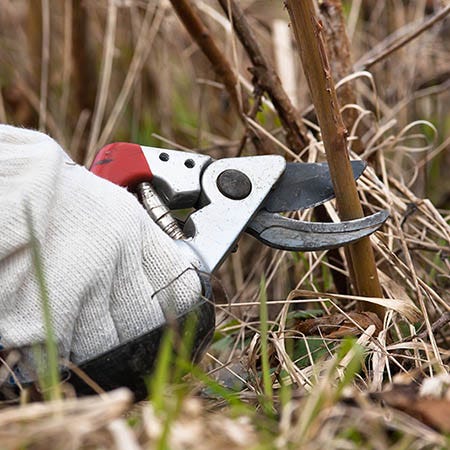How to Prepare Flower Gardens for Spring
Tips On Preparing Your Garden Bed For Spring
Tip: before digging into your garden, make sure the soil isn't soggy or frozen. This will limit plant damage and allow for a more 'workable soil' when the temperatures do go up.
Cutting Back & Pruning In Your Garden
The first task you'll face is to cut back dead stems. Spring is a great time to cut back any dead materials that you left in place over the winter (dead plant matter is a valuable support system for pollinators and insects!).
If no new growth is coming up through the ground, then cut the dead stems as low as you can go to make it easier for the new growth to come to the surface. If new growth is appearing through the soil, be gentle and cut as close to the new growth as you can, without damaging it.
If the dead stems or old growth have flopped over, gently give the material a tug to remove it. If the material comes out easily, pull as much away from the new growth as possible, allowing the plant to be exposed. Pulling or tugging is recommended for day lilies, hostas, and grasses and is easier than cutting.
Woody perennials such as lavender, artemisa, and russian sage should be pruned in the spring to maximize growth, since they produce new blooms from existing branches. Prune just above the new growth. Other evergreen perennials, such as coral bells, keep their foliage though winter, so just cut the damaged leaves and the plant will start to produce new foliage shortly.


Raking Debris From Your Garden
After cutting and pruning, it’s time to gently rake your garden. As long as the ground isn't frozen or too wet, you can rake off any leaves, branches and debris that may have settled onto your garden soil during winter. If you notice weeds, this is a great time to weed your garden before applying compost, fertilizer and mulch.
When To Use Compost, Fertilizer and Mulch in the Spring Garden
Once you have cleaned all the debris and your garden is ready, add a layer of compost. Compost is a great way to feed your plants as they grow throughout the season. After laying compost, apply a granular fertilizer, preferably on a day before a gentle rain. Rain helps break down the fertilizer as it is slowly releasing into the soil.
Use a fertilizer that is either 10-10-10 or 10-15-10. The first number is nitrogen, the second number is phosphorus (phosphate) and the last number is potassium (potash). All three ingredients are essential to the happiness of your plants.
To spread fertilizer, use a conventional spreader or make your own, (an old Parmesan cheese container is an excellent spreader, or a used milk container with holes punched in the bottom). To prevent plant stems and foliage from 'burning', spread the fertilizer around the base of the plants that are appearing, but make sure it doesn't make direct contact with the leaves.
One of the final steps in prepping your perennial gardens, is to add a layer of mulch. If you are planning on adding or dividing your plants, omit this last step until you're ready. If your garden is ready to go, apply 2-3 inches of mulch, such as shredded bark or pine needles. Mulch helps retain water when needed and keep weeds at a minimum. If you use cedar mulch it is a natural mosquito repellent, something to consider if you live in a woodland or wetland area.
The very last step is, enjoy your garden! Happy Gardening.
